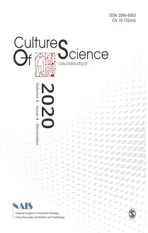The outlook for China’s innovation-driven development beyond COVID-19
2020-05-07
Chinese Academy of Social Sciences,China
Abstract In the post-COVID-19 era,high-quality development will be a key characteristic of China’s economic development.Despite the disruption caused by the pandemic,China’s economy has remained on track for stable and long-term development.In the bid to drive China’s economic transition from factor-driven to innovation-driven development,it is imperative to improve total factor productivity,and that effort should focus on five key factors:urbanization and labour migration;the spillover effect of foreign technologies;human capital enhancement;scientific and technological progress;and marketization process.It is important to align with the main trends and directions of the scientific and technological revolution and industrial transformation.It will be increasingly necessary to focus on developing a dominant technological system represented by next-generation information technology,biotechnology,new energy sources and new materials and to leverage key accelerators of progress,including institutional reform,market optimization and indigenous innovation in order to advance high-quality economic development.
Keywords Chinese economy,COVID-19,innovation-driven development
As the Chinese economy moves from high-speed growth to high-quality development,the sudden outbreak of COVID-19 has created uncertainties for the future.Due to the impact of the pandemic,the global economy is mired in deep recession.The hard decoupling of the global industrial chain has dealt a heavy blow to globalization,further aggravated the recession of the real economy,increased business closures and unemployment,and once again locked the world economy in a low-growth zone.Faced with the challenge of COVID-19,it is important to make a clear assessment of the Chinese economy,grasp the future trends in science and technology and improve the national innovation system.These are all urgent issues that need to be addressed to promote innovationdriven development in China.
1.The current status of the Chinese economy
Having achieved an industrialized economy and taken big strides to keep up with the times,China is going through a transition from high-speed growth to high-quality development.
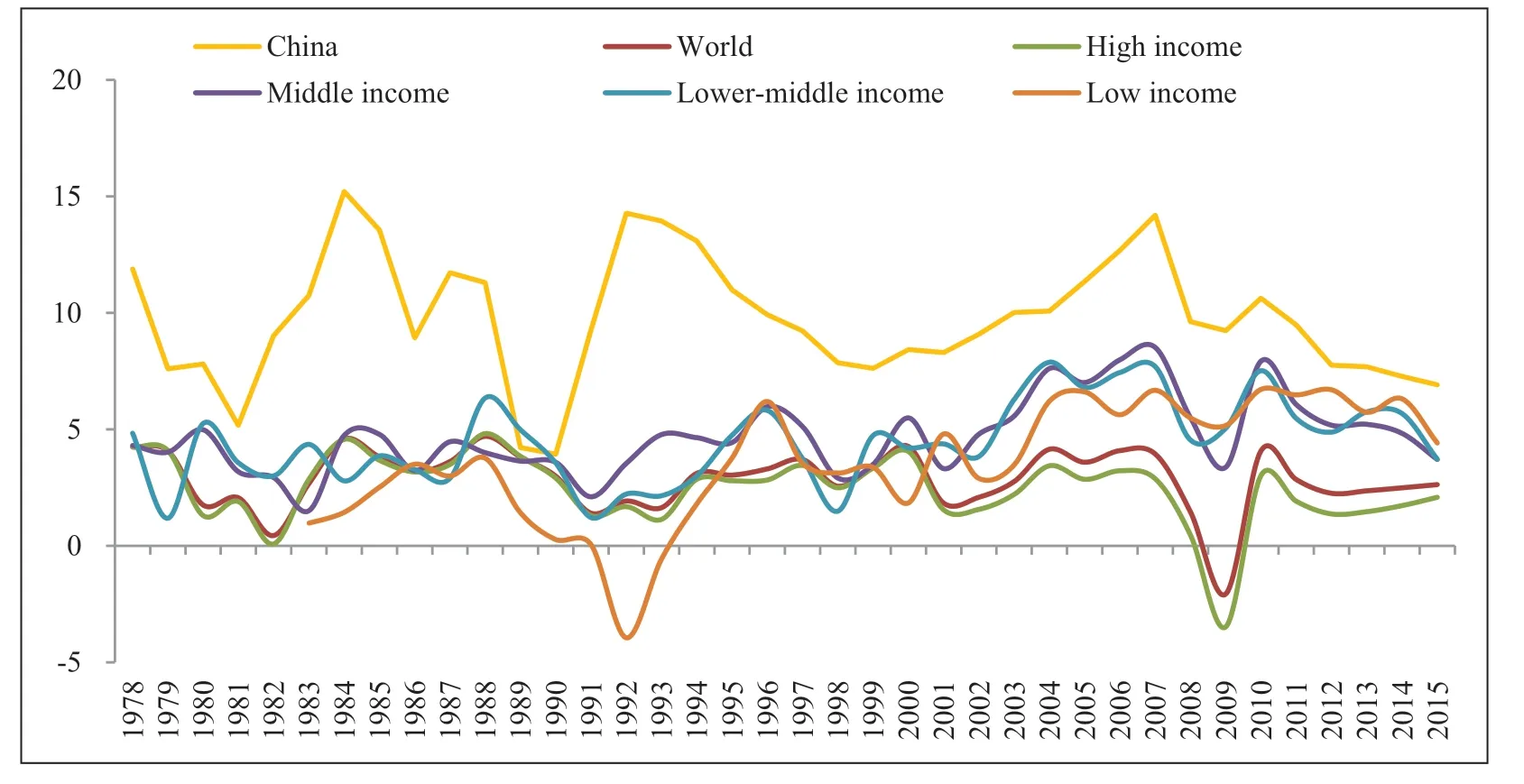
Figure 1.GDP growth:China’s performance compared with world average and different types of economies.

Table 1.China’s world ranking in GDP.
1.1 Growing economy and increased international status
China has experienced tremendous changes since its reform and opening-up.Through 40-plus years of development,its comprehensive national strength has reached the world’s advanced level,and its international status has significantly increased.
Between 1978 and 2019,China’s GDP expanded from US$149.5 billion to US$14.3 trillion,registering an average annual growth rate of 9.5%,or three times the global average.China’s share in the global economy increased from 1.8% to 16%,and its global economic ranking rose from 12th to 2nd place.For decades,China has contributed over 30% to world economic growth,creating a miracle in the history of human development (Figure 1 and Table 1).
1.2 From extreme poverty to uppermiddle income

Figure 2.Changes in China’s industrial structure:percentages of industry types,1978-2016.
In the initial stages of reform and opening up,China was a low-income country on the verge of extreme poverty.With a per capita GDP of only US$156,the Chinese people were barely able to meet their basic food and clothing needs.In 1998,China escaped the low-income trap and joined the ranks of lower-middle-income countries.In 2012,China became an upper-middle-income country,and its per capita GDP topped US$10,000 in 2019.It is predicted that,by around 2025,China will have joined the ranks of high-income economies.By contrast,the vast majority of the economies that were previously in the low-income bracket with China remain low-income countries.Take Africa and India,for example.Africa’s per capita GDP was US$755 in 1998,and China’s was US$775,so they were very similar in the early stages of their economic take-off.In India’s case,40 years ago,its GDP and global ranking were both higher than China’s.However,in 2019,China’s per capita GDP had reached the upper-middle income threshold of US$10,000,while Africa’s was US$1800 and India’s was US$2000.Both economies were still trapped in the low-income bracket and at the early stage of industrialization.
1.3 A particular path of industrialization:Continued improvement on economic structure and modernization
In 1954,at the first session of China’s first National People’s Congress,Chairman Mao Zedong shared his vision of ‘building an industrialized,culturally advanced great country’.Achieving industrialization was a goal pursued by several generations of the Chinese people.Recognizing the impact of industrialization on high-speed growth,China has made sustained efforts to push for industrialization.Among the changes in economic structure,secondary industry has accounted for a large proportion of the economy and has served as the engine for high-speed growth;primary industry has contracted as a share of the economy;tertiary industry has steadily expanded in scale;productivity has grown and the industrial structure has improved (Figure 2).With a complete industrial system,China is now the world’s largest manufacturing country,accounting for 19.8% of global manufacturing output.The basic completion of industrialization is a monumental achievement in China’s endeavour to rapidly catch up with the times.
China’s industrialization process stands in stark contrast to that of India (Figures 3 and 4).Since the late 1960s,the share of secondary industry in the Chinese economy has always stood above 40%,leading to a substantial decline in the share of agriculture and a massive transfer of the rural labour force.The share of the population making up the rural labour force dropped from 70% to less than 30%,and labour productivity continued to increase significantly.In India,secondary industry’s share has stayed at around 30%,and the rural labour force,which has been migrating slowly,still accounts for 50% of total employment.Due to India’s slow progress in upgrading its industrial structure,the country has been unable to benefit from the high-speed growth triggered by industrialization.Forty years ago,India was more economically advanced than China.Today,the Chinese economy is four times bigger than India’s in both aggregate and per capita terms.The two countries are at very different stages of development.

Figure 3.Industrial structures,1960-2016:China (top) and India (bottom).
After more than 40 years of sustained high-speed growth,China has effectively completed its industrialization.The following are three examples of fundamental changes in China’s economic development.
First,China’s tertiary industry surpassed secondary industry in 2012 and became the largest sector in the national economy for the first time.The added value of the tertiary sector accounted for more than 50% of GDP in 2015.The transition of the Chinese economy from being dominated by secondary industry to being dominated by the tertiary industry is evident.
Second,China’s urbanization rate reached 51.3%in 2011,exceeding 50% for the first time.In 2014,more jobs were created in cities than in the rural regions,and urban jobs accounted for 50.9% of total employment.Forty years ago,China was still a traditional and backward rural society with an urbanization rate of only 18%.Today,it has grown into a modern urbanized society,with fundamental changes in social dynamics.
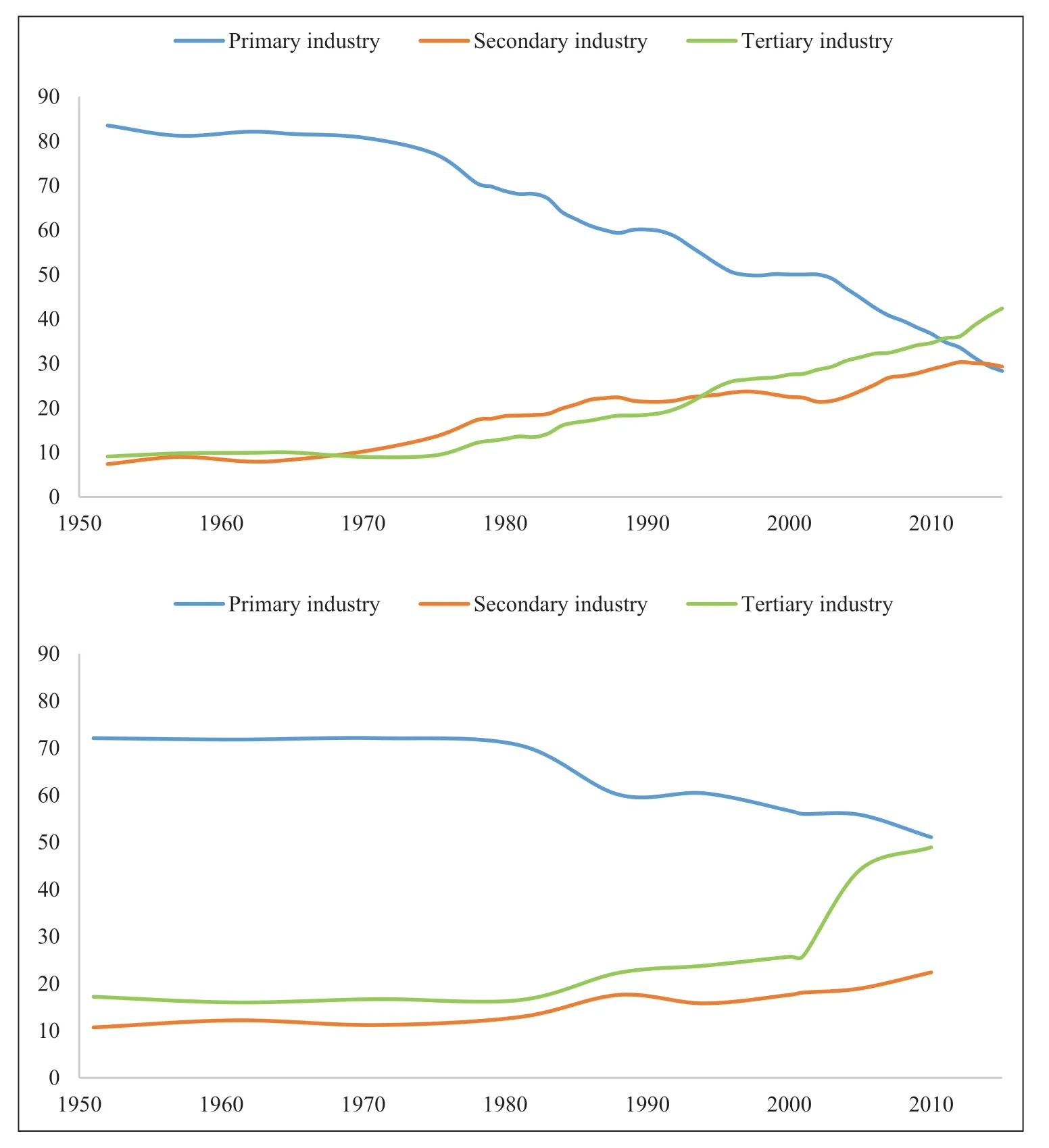
Figure 4.Employment structures:China,1952-2015 (top);India,1951-2010 (bottom).
Third,the final consumption rate increased to 51.2% in 2014,and its contribution to economic growth increased to 50.2%.The long-standing model of investment-driven growth underpinning the Chinese economy has gone through fundamental changes.
All those statistics show that China is moving from a stage of high-speed growth to a stage of high-quality development,consolidating the gains of industrialization and pushing for a transition towards post-industrialization.
2.The trend of steady growth and a favourable long-term trajectory

Figure 5.China’s quarterly GDP growth,2005-2020.
The COVID-19 pandemic has seriously disrupted the world economy.In itsWorld Economic Outlookof 13 October 2020,the International Monetary Fund predicted that global GDP will have contracted by 4.4%this year,with the developed economies down by 5.8%,the US economy by 4.3%,the Eurozone economies by 8.3%,the UK economy by 9.8%,emerging markets and developing economies by 3.3% and the Indian economy by 10.3%.This will be the worst global recession since the Great Depression,and the road to global economic recovery is likely to be long and difficult.The Chinese economy has also been severely affected by the pandemic,slumping by 6.8% in the first quarter but rebounding quickly to 3.2% growth in the second quarter and 4.9% growth in the third quarter (Figure 5).According to predictions from the Institute of Quantitative and Technological Economics of the Chinese Academy of Social Sciences,China’s economic growth will reach 6.5% in the fourth quarter and 2.9% for the whole year.Such a strong performance among the world’s major economies is testimony to the resilience of the Chinese economy.
At the National People’s Congress and the Chinese People’s Political Consultative Conference in May 2020,General Secretary Xi Jinping elaborated on the importance of scientifically analysing and understanding the overall trend of development and taking a comprehensive,long-term view of the economic situation.In the face of the COVID-19 pandemic and changes unseen in a century,the following three major trends of China’s economic development will continue.
First,the Chinese economy is in the process of shifting its growth model,optimizing economic structure and changing growth drivers,and is still at the stage of transitioning from high-speed growth to high-quality development.
Despite problems in the Chinese economy that have accumulated over the past 40 years since the reform and opening-up,China is one of the few countries that has effectively completed its industrialization process.Making big strides to catch up with the times,China has grown into the world’s second largest economy.In 2010,the growth of the economy reached a double-digit rate of 10.6% and then began to slow.From 2015 to 2019,economic growth stayed within the range of 6%-7%,demonstrating that China has moved from a stage of highspeed growth to a stage of medium-high-speed growth,indicating a solid foundation for maintaining development in the future.
Second,China is still facing the difficulties and challenges posed by intertwined structural,institutional and cyclical problems.
The primary problem facing China is,of course,deceleration.The ‘troika’ driving economic growth-investment,consumption and imports and exports-have all declined considerably since the fourth quarter of 2019.China’s economic growth has long been driven by investment.According to our institute’s estimates,capital contributed to 60% of China’s GDP over the past 40 years.On the one hand,the sustained input of massive investment has enabled China to maintain high-speed growth and become the world’s second largest economy.On the other hand,the investment-driven economy is facing a serious test:a sharp decline in investment efficiency and serious overcapacity.
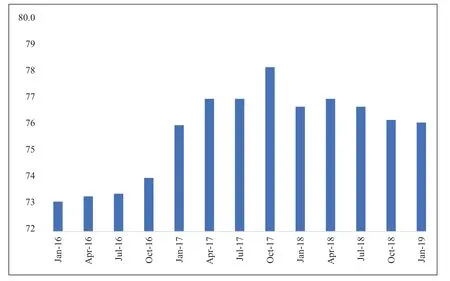
Figure 6.Capacity utilization rate in China,2016-2019.
During the stage of high-speed growth,an increase of 1 unit of GDP required about 2.5 units of investment,but now an increase of 1 unit of GDP requires 8 units of investment.Investment has thus become inefficient and has even produced negative effects.
China took on the problem of overcapacity in the late 1990s,but with little result.The expansion in overcapacity has become a persistent issue in the Chinese economy.In recent years,the utilization rate of China’s production capacity has been only about 76%,which is far below the appropriate range (Figure 6).This has resulted in growing risks of bad debt in the banking sector and declining corporate profits.
From the above,we can see that the model of high-speed growth driven by investment is no longer sustainable.At the same time,China’s economic growth is also facing some long-term challenges,such as waning demographic dividends,widening income gaps and growing energy and environmental constraints.There is an urgent need to shift from factor-driven to innovation-driven growth.
Third,China’s significant institutional advantages,solid industrial base and huge domestic market remain unchanged.
China has a complete industrial system,a megasized domestic market and a large,highly educated population.The country is going through a rapid process of industrialization,informatization,urbanization and agricultural modernization.New economic drivers are emerging or rapidly growing in high-tech,equipment manufacturing and strategic emerging industries.In recent years,China’s Engel coefficient has dropped from 60% at the beginning of the reform and opening-up to less than 30%.The demand for services (transportation,communication,culture,education,health care,etc.) in household consumption has grown faster than the traditional form of material consumption (food,clothing,housing,etc.),indicating a fundamental change in the structure of consumption.Having demonstrated remarkable institutional strengths during the COVID-19 pandemic,China’s role in supporting world economic growth can only grow stronger.
3.Facilitating a shift from factordriven to innovation-driven development
Over the past 40 years,the Chinese economy has maintained high-speed growth,but it has focused mainly on scale and has had low efficiency.To analyse the main factors influencing China’s economic growth and their contribution,the Institute of Quantitative and Technological Economics of the Chinese Academy of Social Sciences has examined the factors using the classic Solow growth model(Table 2).The results show that the contribution of capital to GDP is as high as 60%,while the contribution of total factor productivity (TFP) is only 33%.The character of the factor-driven development model is evident.
Since the global economic crisis in 2008,the speed of China’s economic growth has continued to moderate.On the demand side,the three driving forces of investment,consumption and imports and exports have all lost steam,and long-term and shortterm problems have significantly increased.Therefore,the traditional model of factor-driven development is no longer sustainable,and the need to promote economic transformation and upgrade is urgent.China’s economic growth needs to shift from being driven mainly by investment and exports to being driven by consumption,investment and exports all at the same time,from relying mainly on secondary industry to balanced contributions from primary,secondary and tertiary industries,and from relying mainly on increased consumption of material resources to relying mainly on scientific and technological progress,improved quality of the labour force and innovation in management approaches.That is to say,development must shift from being factor-driven to being innovation-driven.
Viewed in the context of the three key factors on the supply side (capital,labour and TFP),the aim of innovation-driven development is to boost TFP.TFP or,in other words,innovation,is essentially a ‘black box’,and everyone is talking about it.But what exactly is innovation? What factors are involved?What is the transmission mechanism from innovation to economic growth? To answer those questions and open the ‘black box’,our institute has used empirical methods to analyse the factors that have played a key role in the TFP of the Chinese economy over the past 40 years and has identified five key factors underpinning growth:urbanization and labour migration;the spillover effect of foreign technologies;human capital enhancement;scientific and technological progress and marketization process (Figure 7).

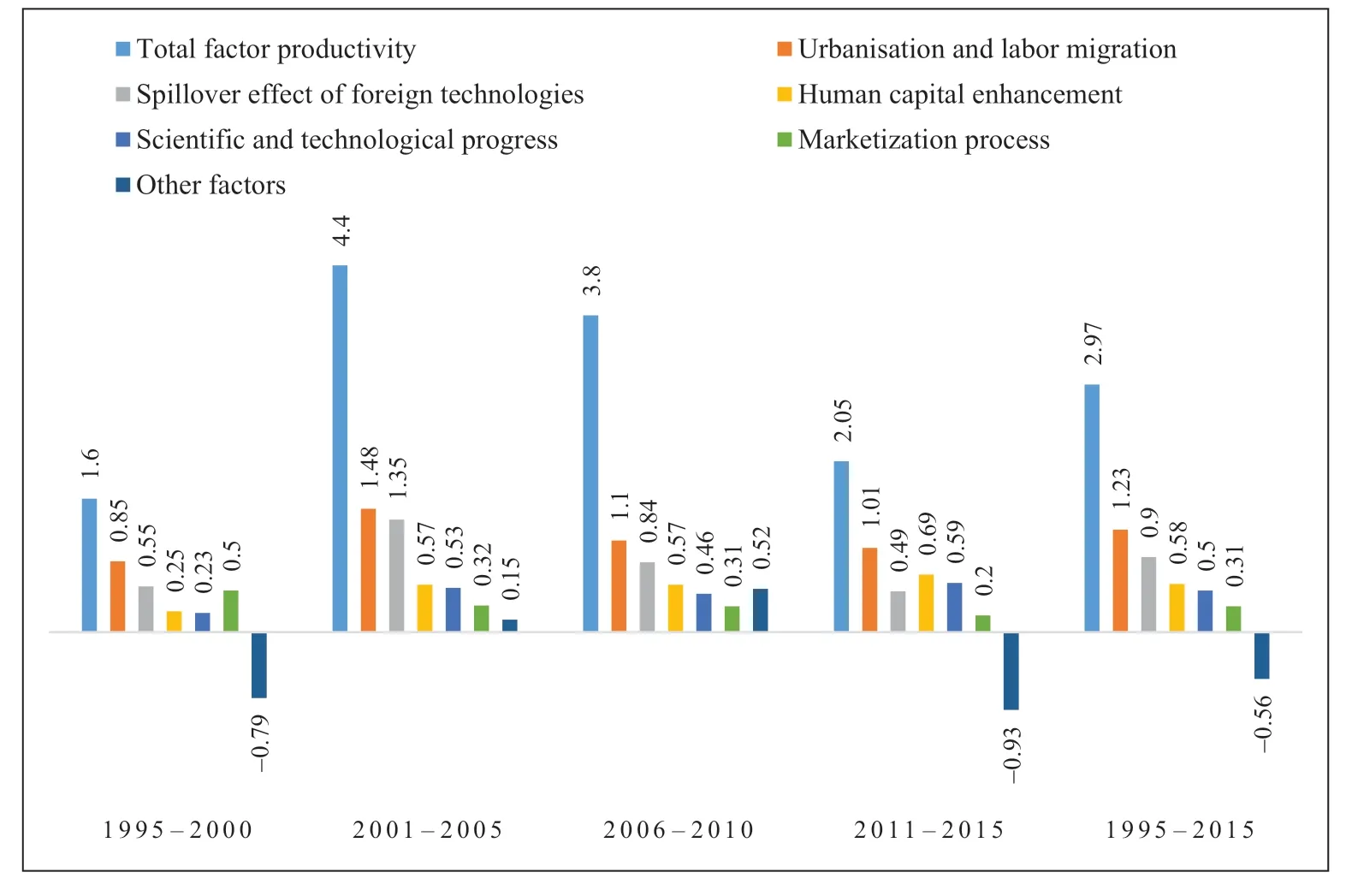
Figure 7.Decomposition of China’s TFP,1995-2015.
Over the past 40 years since the reform and opening-up,the five factors have contributed the most to China’s TFP.
(1) Urbanization and labour migration.China’s urbanization rate has risen from 18% to 60%,the share of labour force in rural areas has dropped from 70% to less than 30%,and there has been a large-scale movement of the labour force from the primary industry to the secondary and tertiary industries.The labour productivity of China’s secondary and tertiary industries are 4 times and 3.5 times that of the primary sector,respectively.This large-scale labour migration has optimized the allocation of labour resources and has significantly boosted labour productivity across society.
(2) Spillover effect of foreign technologies.China is firmly committed to promoting openingup and attracting and utilizing foreign investment.As a result,the technological standards of the industrial sector have improved notably.Technology and knowledge have generated positive spillover effects and produced a large number of skilled industrial workers.
(3) Human capital enhancement.China attaches high importance to culture and education.Guided by the strategy of invigorating the country through science and education,the country continues to increase investment in education.The gross enrolment rate of universities has markedly increased,the scientific literacy of the population has notably improved and the size of the scientific and technological workforce has ranked first in the world for several years straight.
(4) Scientific and technological progress.China sees science and technology as the primary productive force.Through constant investment in science and technology,which is already higher than the average of OECD countries,it has substantially enhanced its scientific and technological strength and now ranks among the world’s top performers in the production of scientific papers,patents and other intellectual output.Science and technology are now playing an increasingly important role in the country’s economic development.
(5) Marketization process.In 1992,China set the goal of building a socialist market economy and started the reform of the planned economic system.The strengthening of the institutions and mechanisms of the market economy and the release of reform dividends have greatly boosted social productivity.
The above five factors remain the key driving force for future economic development,and also the main lever for pursuing innovation-driven development.
4.The way forward for promoting scientific and technological innovation in China
In 2012,the 18th National Congress of the Communist Party of China clearly stated that scientific and technological innovation provides strategic support for driving productivity and boosting overall national strength,and we must give it top priority in overall national development.Only by understanding development trends in science and technology can we reach the highest level of scientific innovation and become competitive in international competition.
Based on our institute’s predictions of technology trends and the research conclusions of the world’s major countries,it can be inferred that the future science and technology system will be led by a new generation of information and network technologies,including biotechnology,new energy sources and new materials.This reflects mainstream trends and the direction of the current scientific and technological revolution and industrial transformation.The new generation of information and network technologies,technologies of biomedicine and health and new energy technologies can be applied on a large scale in the next 2-3 years.
A new round of scientific and technological revolution is rapidly emerging and demonstrates the following features:
· Major breakthroughs and developments in scientific research are on the horizon,and new forms of general sciences and even new scientific systems will begin to emerge.
· Multiple breakthroughs and clusters will emerge at the same time in frontier technologies,leading to shorter technology life cycles.
· Diversified and deep integration of scientific and technological innovations and blurred disciplinary boundaries will facilitate humancyber-physical integration and increasingly unify the physical,digital and biological fields.
· A paradigm revolution in science,technology and innovation is under way,triggering significant changes in research organizations and leading to more individualized,open,networked and cluster-based research and innovation activities.
· Disruptive innovations are spreading on a large scale,permeating society on many levels and having a profound impact on the means of social production.They constitute a push for revolutionary changes in our means of production,business models,way of life and way of learning and thinking.
· Scientific and technological innovation is highly complex and volatile and is having a huge impact on economic and social development.It will destroy the old productive forces and relations and escalate the tension between the traditional institutional system and the new social productive forces in China.This has raised new requirements for innovation in the science and technology system.
Global competition in science and technology is escalating,particularly between emerging and established powers.Changes in the global science and technology governance system and the international order are accelerating,and China will become an important participant in global science and technology governance.That said,China still trails far behind developed countries in building an innovative national system and is confronted with many risks and challenges.
5.Policy recommendations for innovation-driven development
Innovation-driven development requires further deepening reforms to build a modern national innovation system and fostering synergy among various innovation entities.While strengthening basic research and improving the basic system,it is also important to seek more breakthroughs in core technologies.Efforts should be made to establish an effective cross-sectoral coordination mechanism,improve science,technology and innovation policies and boost TFP.
5.1 Deepening the reform of administrative institutions and actively transforming government functions
The key to promoting supply-side structural reform,activating the market and motivating enterprises is to properly handle the relationship between the government and the market.As the supply of traditional factors of production (such as capital and labour) has shown a diminishing return on scale,new factors of production (information,technology,innovation,management,data,etc.) represented by TFP must be leveraged to sustain China’s growth momentum in the future.The cultivation,development and growth of those new factors require a relaxed and free market environment.Therefore,the government should make the transformation of functions the focus of administrative reform and set a reasonable boundary between the government and the market by establishing legally binding ‘mandate lists’,‘negative lists’ and ‘lists of responsibilities’ to prevent the government from evading responsibilities or overstepping,and to minimize the government’s role in managing and overseeing micro-level affairs.At the same time,a sound administrative mechanism with proper checks and balances among the government’s decision-making,executive and supervisory powers must be established to further streamline administration and delegate power.It is also important to further open up and invigorate the market to fully leverage its enabling effect and decisive role in resource allocation.Market mechanisms for price formation,cost transmission and investment returns must be established to match factor input and cost constraints with return on investment.The market must play a guiding role in promoting the organization of industries,products and projects and setting technical routes and directions,and backward and excess capacity must be eliminated through market means.‘Mass entrepreneurship and innovation’programmes and the market-based operation of private capital must be advanced to drive market development and boost consumption.The practice of ‘locking the market in the cage of power’ must be avoided.
5.2 Breaking up monopolies,reforming the system of state-owned enterprises and creating a market environment for full and fair competition
Both world history and economic theory have proven that monopoly will not only aggravate market contradictions and impede industrial upgrade and transformation but also curb innovation in technology and management.It may also escalate social tensions,disrupt resource allocation efficiency and affect the fair distribution of social wealth.At present,two factors seriously discourage the research and development (R&D) activities of Chinese enterprises:short-sighted behaviours and acts of monopoly.At the same time,due to the existence of monopolistic industrial policies,coupled with the low degree of openness to private capital in telecommunications and other service sectors,it is difficult for private investors to enter those competitive fields,which not only affects the effective allocation of resources but also prevents private capital from playing its important role.More importantly,such an unfair development system has posed a serious obstacle to technological innovation and producer incentives.Therefore,the government must speed up the building of a unified,open market system for orderly competition by formulating and improving relevant laws and regulations,establish a guarantee mechanism for fair competition and break up regional segmentation and industrial monopolies so as to better unlock the vitality and creativity of a market economy.
5.3 Strengthening the capacity for independent innovation and improving the mechanism and environment for scientific and technological innovation
The essence of competition among modern enterprises is the competition of technologies.Only by attaching importance to scientific research and technological innovation can enterprises possess their own core technologies and keep their destiny in their own hands.This is crucial for their long-term survival and growth in all kinds of environments,both favourable and otherwise.
At present,the Chinese economy is in a critical period of industrial restructuring and upgrading,and the environment for exports is increasingly severe,which heightens the need for strengthening scientific and technological innovation.Under such circumstances,we must seize the development opportunity provided by supply-side structural reform,formulate and improve the relevant plans and industrial policies to boost the independent innovation of enterprises,support the development of venture capital institutions,optimize fiscal reform and management laws on the research activities of the business sector,introduce science and technology policies that can truly encourage and guide enterprises to increase R&D input and develop new technologies and address the concerns of businesses to facilitate investment in R&D.We must also improve investment and financing policies,address financing difficulties through a pledge of intellectual property rights,multiple forms of science and technology insurance schemes,high-tech zone bonds and venture capital funds and support businesses in conducting technological innovation.
In addition to the above,we must enhance the protection of intellectual property rights,improve the support mechanism for the commercialization and industrialization of R&D outputs,strengthen the technology service system and technology property rights trading system and establish a sound external environment for the protection of businesses’ intellectual property rights,so as to fully guarantee the economic and social benefits generated by the independent innovation of enterprises.To help scientific and technical personnel become reasonably affluent in accordance with the law is a direct and effective means for encouraging enterprises and professionals to engage in scientific research and innovation.
5.4 Replacing quantity with quality and efficiency and improving capital utilization and labour productivity
While promoting scientific and technological innovation and striving to boost TFP,we must put the focus of supply-side structural reform on improving the efficiency and quality of the supply of traditional production resources and factors.On the one hand,given the fact that it is difficult to change China’s demographic trend in the short term,and in order to meet the demands of the modern economy,it is necessary to increase investment in human capital,transform demographic dividends into talent dividends and improve the quality of the workforce to offset the negative effects of waning demographic dividends.At the same time,we must build a unified labour market,optimize labour allocation,reduce the cost of the free movement of labour,promote the orderly movement of labour between urban and rural areas,enterprises,universities and scientific research institutions,reasonably raise the retirement age for technological and managerial personnel,encourage the elderly population to work longer,tap the potential of the labour supply,shift the focus of population strategy from controlling population growth to optimizing and improving population quality,enhance the quality of education and training and steadily improve the quality of the workforce.Moreover,during the 14th Five-Year Plan period,the government should extend the period of compulsory education to 12 years,promote the strategic alliance between industry,academia and research institutions,raise the core competitiveness of industries and ensure the smooth and effective transition of development stages.On the other hand,we should accelerate the implementation of reforms in the financial sector,improve the efficiency of capital utilization,stop acts of monopoly and profiteering by financial firms,speed up the construction of a multi-layered financial system matched with the real economy,establish diversified organization systems and vertical service systems,integrate various forms of financial resources,speed up market-oriented financial reform and effectively bring down the cost of funding for enterprises,particularly small and medium-sized enterprises.
Declaration of conflicting interests
The author declared no potential conflicts of interest with respect to the research,authorship and/or publication of this article.
Funding
The author received no financial support for the research,authorship and/or publication of this article.
Author biography
Ping Li is a researcher and a doctoral supervisor.He is also the director of the Institute of Quantitative and Technological Economics of the Chinese Academy of Social Sciences.His research interests include scientific innovation and industrial economy and project evaluation.
杂志排行
科学文化(英文)的其它文章
- A reconsideration on telling good stories about Chinese scientists and shaping the exemplary image of scientists amid the anti-pandemic campaign
- Introduction:The COVID-19 pandemic calls for the strengthening of scientific culture
- A tentative discussion of medical education and cultures of science
- Constructing scientific culture in the 5G era:Historical lessons from the first discovery of a virus
- In what sense should we talk about the perception of other minds?
